Eventually, after Sir John had made suggestions and alterations, Belgrove, the designer, had decided it was ” stylish and aesthetic,” and Grinham had checked the weight and cost, Black’s new baby was ready to go into full production. It was then that thirty-four year old Les Watson, charge hand on the Triumph Mayflower motor assembly line, got his first engine blocks of the new model.
The Mayflower was going out of production, so all Watson’s men, except six whom he kept back, went to work on tractors made in the Standard factory. Watson and his six engineers bench-built four engines from parts supplied by the factory. They looked for teething troubles and familiarized themselves with every part. After three days’ they reported that they could deal with them at speed, and the mass-production of the new 8-h.p. engines began. In the main assembly line the bodies were corning on overhead lines ready to be dropped on to the engines’ and axles.
There is no chassis —that was also cut out to save cost. One of the most fascinating sights is to watch wheels of one colour coming along one overhead wire and unfailingly meeting a body of the same colour to be fitted together with the engine below. This strangely magical process does not _impress the practical Sir John. He says: ” If you put things in their right order at the beginning they will come out in their right order at the other end.” As soon as the first mass-produced model slid off the slow-moving assembly track, Sir John jumped into it and drove off, looking for the worst potholes he could find near Coventry. After he had driven it round the Warwickshire countryside looking for faults, he went to the Welsh mountains with another model to give it a greater endurance test.
At first the new Eights were coming off the assembly line at the rate of two an hour, but every week Frank Nott, foreman of the assembly department, who sits in an office like a signal-box overlooking the moving tracks, altered his switches. Next door to his office is an instrument panel with flashing lights and illuminated dials. This controls the speed of the assembly lines. As the production trickle becomes a torrent, more and more men are put on the quickening lines. On a slow line a man can do three operations to the car, but, as the track begins to speed up, his operation is reduced to one, and two other men will be put with him to keep pace with the faster track. The track speed has now risen to a hundred cars a day, and in the New Year a new baby Standard will roll off the line every two and a half minutes. That is what Sir John Black meant when he said that he wanted to have plenty of them available for everyone. As they come of the tracks, like coloured links in an endless chain, a tall athletic figure in a light-grey suit will come bustling in, jump into the nearest car, and drive off. That will be Sir John Black going off in search of the biggest pothole he can find.

